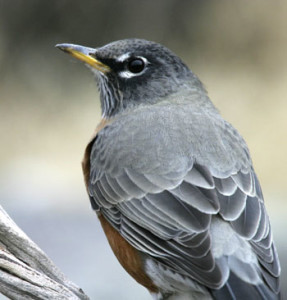Nature Notes by Dr. Frank Lang
“Sing a Song of Six Pence, Pocket Full of Rye, Four and Twenty Blackbirds, Baked in a Pie.”
I took my first visit to Great Britain several years ago to chase the ghosts of David Douglas and John Jeffrey. I was amazed (I am easily amazed, you know) to discover that the blackbirds of that Mother Goose poem are pretty much like our American robin, except the males are a handsome black with a yellow eye ring and bill. They seemed to act the same.

I knew about the European robin, not a thrush at all, nestled in British checklists between nightingales and bushchats. Seeing one of these bold little birds an arm’s length away in the bushes at Kew Gardens was a thrill.
Ever notice how our robins hunt for earthworms? They hop across the lawn, stop, cock their heads to one side, as if listening intently to wormy sounds, trying to locate their prey. Silly us, when we cock our heads to listen, our eyes stare straight ahead. Robin’s eyes aren’t oriented like ours. When they cock their heads, they stare straight down. We humans naturally assume robins are listeners. Wrong again. Experiments show that robins find their earthworm prey by sight, not sound.
Robins are migratory birds. The robins who nest in our area move farther south in winter and are replaced by robins from farther north. We see two subspecies, the darker northwestern robin from Alaska and Canada, and the lighter-breasted western robin. The robins’ sexual dimorphism complicates distinguishing the subspecies. Male robins are darker than females of the same subspecies.
Birds my mother called Alaska robins, I now know as varied thrushes. They resemble their close relative, the orange-breasted robin, in size and shape and habits. Varied thrushes are striped, orange above the eye and black across the breast. These birds are sleeker, shier and prefer coniferous forests to lawns. They sometimes visit feeding stations in winter when they come down from high mountains. At my childhood home I remember them eating apples on the snowy ground under the big apple tree across the driveway from the living room window.
The famous old-time naturalist and author John Burroughs wrote the following verse when he saw the varied thrush for the first time.
|
0 Varied Thrush! 0 Robin Strange! Behold my mute surprise. Thy form and flight I long have known, But not in this new disguise. |
But, back to robins. My same childhood home had two huge mountain ash trees overhanging the street on either side of the walk to our front door. The trees always seemed to bear an enormous load of fruits in the fall. The trees were orange, the same color as a robin’s breast. The same color any automobile became whose unwary driver was foolish enough to park under the tree when robins descended to feast on mountain ash berries. I swear the combination of acid berries and digestive juices caused the automobile’s paint to pit.
That reminds me of more poetry, this time Mother Goose. Mother Goose wasn’t always the sanitized pablum of today. If you are easily offended, I suggest you stop reading now.
|
Little Robin red breast, Sitting on a pole, Niddle, Noddle, Went his head, And poop went his hole. |
Sorry folks, but that’s the way it is in the real world!
— Dr. Frank Lang
Other pages in this section
- Dr Frank Lang obituary, May 14, 1937 – June 26, 2019
- Alkali Flies
- Bald Eagles
- Bull Trout
- Christmas Trees
- Cryptosporidiosis
- Cucurbits
- Dicamptodon
- Dippers
- Earthworms
- Fens
- Fishing
- Grapeferns
- Helliborine Orchid
- Habitat
- Hairy Woodpecker
- Hibernation
- Klamath Midge
- Marshes
- More Yellowjackets
- Morels
- Mosquito Fern
- Mountain Beaver
- Myriapods
- Painted Ladies
- Pandora Moths
- Pikas
- Pronghorns
- Raccoons
- Shaggy Manes
- Silver-Gray Squirrels
- Slugs
- Soils
- Songbirds
- Spotted Owl
- Spotted Skunk
- Subalpine Fir
- Ticks and Mites
- Water
- Watermelon Snow
- Water Bears
- Wizard Island Toads
- Wocas
- Woodrats
- Yellowjackets
- Dr Frank Lang obituary, May 14, 1937 – June 26, 2019
- Alkali Flies
- Bald Eagles
- Bull Trout
- Christmas Trees
- Cryptosporidiosis
- Cucurbits
- Dicamptodon
- Dippers
- Earthworms
- Fens
- Fishing
- Grapeferns
- Helliborine Orchid
- Habitat
- Hairy Woodpecker
- Hibernation
- Klamath Midge
- Marshes
- More Yellowjackets
- Morels
- Mosquito Fern
- Mountain Beaver
- Myriapods
- Painted Ladies
- Pandora Moths
- Pikas
- Pronghorns
- Raccoons
- Shaggy Manes
- Silver-Gray Squirrels
- Slugs
- Soils
- Songbirds
- Spotted Owl
- Spotted Skunk
- Subalpine Fir
- Ticks and Mites
- Water
- Watermelon Snow
- Water Bears
- Wizard Island Toads
- Wocas
- Woodrats
- Yellowjackets

